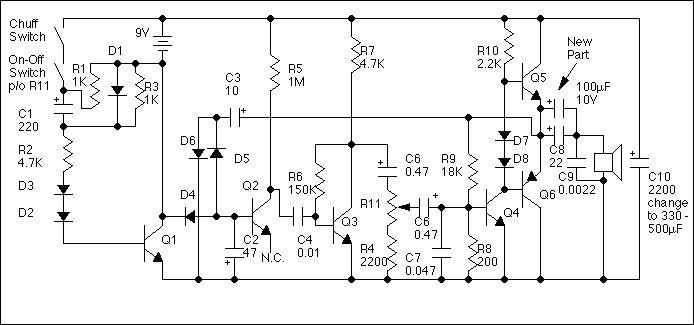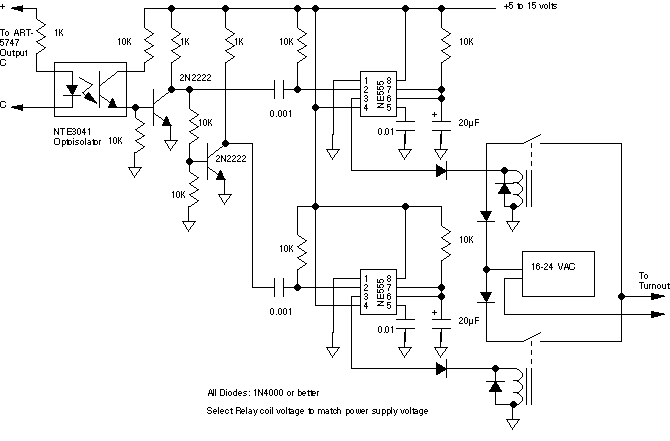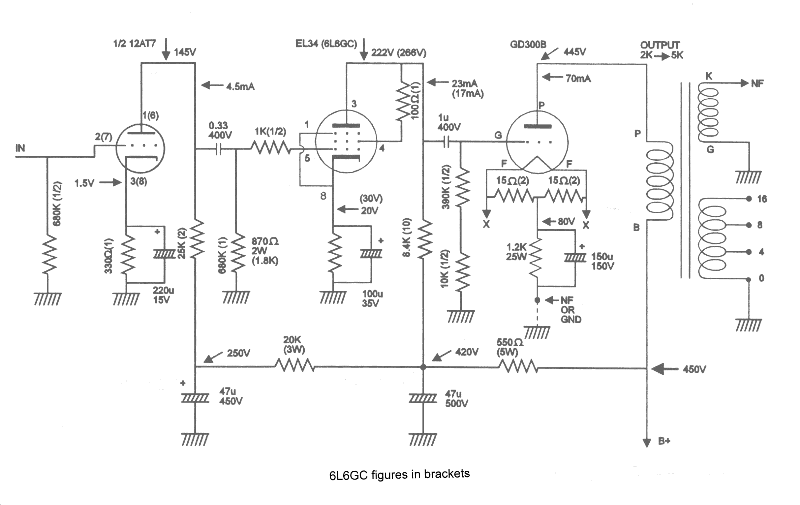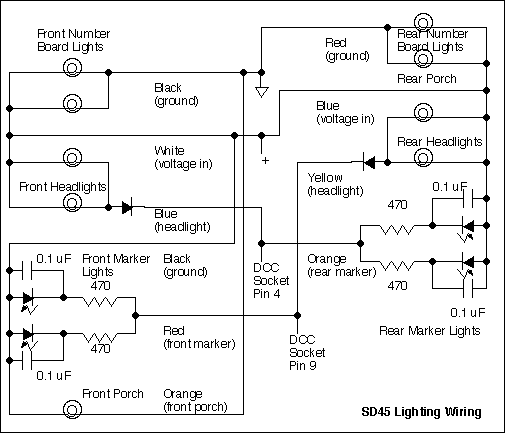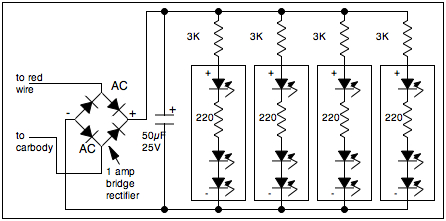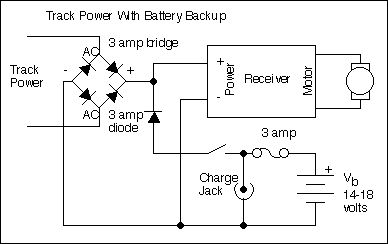
Shay Tips
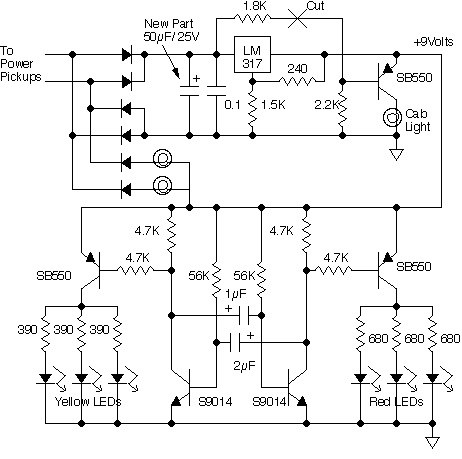
The Shay is equipped with flickering ashpan and firebox lights, which are simulated using LEDs. The red and yellow LEDs flicker, with the red ones remaining on approximately two-thirds of the time and the yellow ones one-third of the time. The effect is most noticeable when the engine is moving at speeds significantly higher than the prototypical maximum of 10-12 mph. The flickering speed is somewhat dependent on the power pack used; for instance, using pure DC may not produce any flickering at all, while Aristo PWC power works slightly better but still may not provide optimal results. The circuit includes an adjustable regulator set to 9 volts and a cab light control circuit in the upper section. The lower section features a multivibrator that controls the flickering of the LEDs. The red LEDs will illuminate at voltages lower than 9 volts on the internal regulated bus but will not start flickering until a full 9 volts is reached. Due to the overhead of the LM317 regulator and bridge rectifier, approximately 12 volts is required on the track to activate the circuit. At 12 volts, the Shay operates at a speed that makes the lights difficult to see. Running at prototypical speeds will not achieve these higher voltages. A 50 microfarad capacitor has been added to the output of the bridge rectifier to smooth out any voltage peaks and ensure the regulator functions effectively at lower average input voltages. With an Aristo Train Engineer that outputs full voltage pulses even at low speeds, this capacitor allows the cab light, headlights, and flickering lights to illuminate fully as the engine begins to move. However, with pure DC power, no noticeable improvement is observed. A downside to this modification is that the cab light begins to flicker heavily. The cab light is controlled by a circuit that turns it off when the input voltage to the regulator IC exceeds a certain threshold. This feature was disabled by cutting a lead on the 1.8K resistor (labeled R9 on the circuit board), allowing the cab light control transistor to remain on continuously. Following this change, the cab light became excessively bright, matching the intensity of the headlight. A 100-ohm resistor was added in series with the cab light to reduce its brightness. To further decrease the intensity of the cab light, one can unsolder one of the wires labeled L1 and insert a 100-ohm resistor in series with the wire. Wiring on the flicker board can be challenging, and a photo is available showing the function of each wire pair. The Shay model includes a standard Bachmann smoke unit, which can be prone to burning out if it runs dry. This presents a challenge, as only a few drops of fluid can be added to the smoke generator, and it consumes the fluid quickly. If the smoke unit produces weak output, it may be possible to enhance the smoke production at no additional cost, as detailed on the Smoke Tips page. However, this may lead to quicker fluid consumption and a higher risk of the unit burning out. One unit was replaced with an LGB smoke unit, which performs better, producing sufficient smoke and lasting over 15 minutes. Plans are in place to utilize an LGB 5-volt replacement smoke element along with a standard 5-volt regulator circuit. This setup can be installed in the same location as the existing smoke element. The circuit design is straightforward: a bridge rectifier converts the track voltage to a constant polarity, and the filter capacitor charges to the peak track voltage, ensuring maximum input to the regulator even at lower track voltages.
The flickering LED system in the Shay model represents a creative solution for simulating the visual effects of fire and ash in a model locomotive. The use of red and yellow LEDs, controlled by a multivibrator circuit, effectively mimics the flickering flames typically observed in real steam engines. The choice of an adjustable regulator allows for flexibility in operation, accommodating various power sources while ensuring that the LEDs receive a stable voltage for consistent performance. The addition of the capacitor enhances the overall responsiveness of the lighting system, particularly when using specific power packs that deliver pulsed voltage.
Furthermore, the integration of a smoke unit adds another layer of realism to the model. By replacing the original Bachmann smoke unit with an LGB unit, the performance is improved, providing a more reliable smoke output while reducing the risk of burnout. The proposed use of a 5-volt regulator circuit for the new smoke element ensures that the smoke unit operates efficiently and effectively, contributing to the overall aesthetic and operational experience of the Shay locomotive.
In summary, the modifications and enhancements described not only improve the lighting and smoke effects of the Shay but also reflect a thoughtful approach to model engineering, balancing functionality with the desire for realistic operation.The Shay is equipped with flickering ashpan and firebox lights. These are simulated with LEDs. The red and yellow ones both flicker, the red ones stay on about 2/3 of the time and the yellow ones 1/3 of the time. The effect is pretty good while it is going, but the engine has to be moving fairly fast, way faster than the prototypical maximum 10-12
mph, before the flickering will start. The speed that the flickering starts is somewhat dependent on your power pack. If you use pure DC, you might not see them start flickering at all. They work a little better with Aristo PWC power, but still not real well. My thanks to Garry Paine for taking the time to trace out the circuit. The top part consists of an adjustable regulator set to 9 volts and a cab light control circuit. The bottom part of the circuit is the multivibrator which flickers the LEDs. It will light the red LEDs at lower than 9 volts on the internal regulated bus, but does not start to flicker until a full 9 volts is reached. Due to the overhead of the LM317 regulator and the bridge rectifier, about 12 volts is needed on the track to get the circuit going.
At 12 volts, the Shay is really trucking so its hard to see the lights anyway. If you run at anything like prototypical speeds, you`ll never get going that fast. I added a 50 micro farad capacitor to the output of the bridge rectifier that will charge off any peaks of power that might be applied to the track so that the regulator has the best chance of working at lower average input voltage. Since I use an Aristo Train Engineer which puts out full voltage pulses even at very low speed, the addition of this capacitor causes the cab light, headlights and the flickering lights to come full on just as the engine starts to move.
With pure DC power there will be no noticeable improvement. The downside of this change is that the cab light starts to flicker heavily. The cab light is driven by a circuit that will shut off the cab light when the input voltage to the regulator IC gets too high. I personally don`t seen the advantage of this "feature" so I disabled it by cutting a lead on the 1. 8K resistor (labeled R9 on the circuit board). This turns on the cab light control transistor all the time. After this change, I found that the cab light was too bright, it shines as bright as the headlight. I added 100 ohms in series with the cab light to tone it down. If you want to reduce the intensity of the cab light, unsolder one of the wires labeled L1 and add a 100 ohm resistor in series with the wire.
If you decide to do any other wiring on the flicker board, locating the wires can be somewhat of a pain. The following photo shows what function each wire pair provides. This photo is of a 1st run Ely Thomas #5 Shay, newer models may or may not be the same. The Shay contains a standard Bachmann smoke unit, which means that it`ll burn up in a short second if you let it run dry.
This is a problem as you can`t put more than a few drops in the smoke generator and it smokes so strongly that the smoke fluid runs out in a couple of minutes. If the smoker works, but smokes weakly, it may be possible to improve the smoke output at zero cost, see my Smoke Tips page for details.
The downside is that it may go through smoke fluid faster and be even more likely to burn up if it runs dry. One of mine burned up so I changed it out with an LGB unit which works much better. It doesn`t generate as much smoke but it generates enough and it`ll run for 15 minutes or more. The plan is to use an LGB 5 volt replacement smoke element and a common 5 volt regulator circuit. All this stuff can be mounted in the location of the existing smoke element. The circuit is straightforward. A bridge rectifier converts the track voltage to a constant polarity. The filter capacitor charges up to the peak track voltage to provide the maximum input to the regulator even at low track voltages.
The regulator drop 🔗 External reference
The flickering LED system in the Shay model represents a creative solution for simulating the visual effects of fire and ash in a model locomotive. The use of red and yellow LEDs, controlled by a multivibrator circuit, effectively mimics the flickering flames typically observed in real steam engines. The choice of an adjustable regulator allows for flexibility in operation, accommodating various power sources while ensuring that the LEDs receive a stable voltage for consistent performance. The addition of the capacitor enhances the overall responsiveness of the lighting system, particularly when using specific power packs that deliver pulsed voltage.
Furthermore, the integration of a smoke unit adds another layer of realism to the model. By replacing the original Bachmann smoke unit with an LGB unit, the performance is improved, providing a more reliable smoke output while reducing the risk of burnout. The proposed use of a 5-volt regulator circuit for the new smoke element ensures that the smoke unit operates efficiently and effectively, contributing to the overall aesthetic and operational experience of the Shay locomotive.
In summary, the modifications and enhancements described not only improve the lighting and smoke effects of the Shay but also reflect a thoughtful approach to model engineering, balancing functionality with the desire for realistic operation.The Shay is equipped with flickering ashpan and firebox lights. These are simulated with LEDs. The red and yellow ones both flicker, the red ones stay on about 2/3 of the time and the yellow ones 1/3 of the time. The effect is pretty good while it is going, but the engine has to be moving fairly fast, way faster than the prototypical maximum 10-12
mph, before the flickering will start. The speed that the flickering starts is somewhat dependent on your power pack. If you use pure DC, you might not see them start flickering at all. They work a little better with Aristo PWC power, but still not real well. My thanks to Garry Paine for taking the time to trace out the circuit. The top part consists of an adjustable regulator set to 9 volts and a cab light control circuit. The bottom part of the circuit is the multivibrator which flickers the LEDs. It will light the red LEDs at lower than 9 volts on the internal regulated bus, but does not start to flicker until a full 9 volts is reached. Due to the overhead of the LM317 regulator and the bridge rectifier, about 12 volts is needed on the track to get the circuit going.
At 12 volts, the Shay is really trucking so its hard to see the lights anyway. If you run at anything like prototypical speeds, you`ll never get going that fast. I added a 50 micro farad capacitor to the output of the bridge rectifier that will charge off any peaks of power that might be applied to the track so that the regulator has the best chance of working at lower average input voltage. Since I use an Aristo Train Engineer which puts out full voltage pulses even at very low speed, the addition of this capacitor causes the cab light, headlights and the flickering lights to come full on just as the engine starts to move.
With pure DC power there will be no noticeable improvement. The downside of this change is that the cab light starts to flicker heavily. The cab light is driven by a circuit that will shut off the cab light when the input voltage to the regulator IC gets too high. I personally don`t seen the advantage of this "feature" so I disabled it by cutting a lead on the 1. 8K resistor (labeled R9 on the circuit board). This turns on the cab light control transistor all the time. After this change, I found that the cab light was too bright, it shines as bright as the headlight. I added 100 ohms in series with the cab light to tone it down. If you want to reduce the intensity of the cab light, unsolder one of the wires labeled L1 and add a 100 ohm resistor in series with the wire.
If you decide to do any other wiring on the flicker board, locating the wires can be somewhat of a pain. The following photo shows what function each wire pair provides. This photo is of a 1st run Ely Thomas #5 Shay, newer models may or may not be the same. The Shay contains a standard Bachmann smoke unit, which means that it`ll burn up in a short second if you let it run dry.
This is a problem as you can`t put more than a few drops in the smoke generator and it smokes so strongly that the smoke fluid runs out in a couple of minutes. If the smoker works, but smokes weakly, it may be possible to improve the smoke output at zero cost, see my Smoke Tips page for details.
The downside is that it may go through smoke fluid faster and be even more likely to burn up if it runs dry. One of mine burned up so I changed it out with an LGB unit which works much better. It doesn`t generate as much smoke but it generates enough and it`ll run for 15 minutes or more. The plan is to use an LGB 5 volt replacement smoke element and a common 5 volt regulator circuit. All this stuff can be mounted in the location of the existing smoke element. The circuit is straightforward. A bridge rectifier converts the track voltage to a constant polarity. The filter capacitor charges up to the peak track voltage to provide the maximum input to the regulator even at low track voltages.
The regulator drop 🔗 External reference
